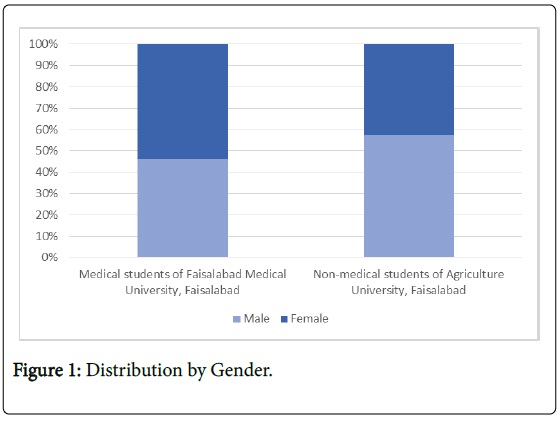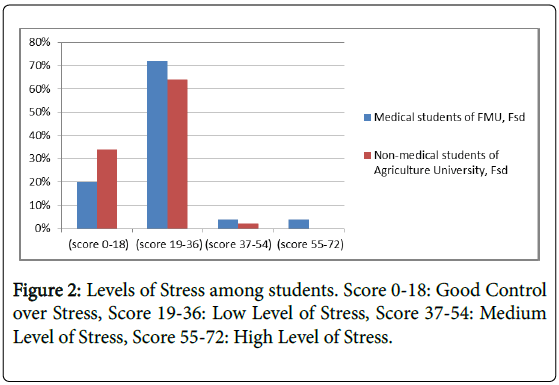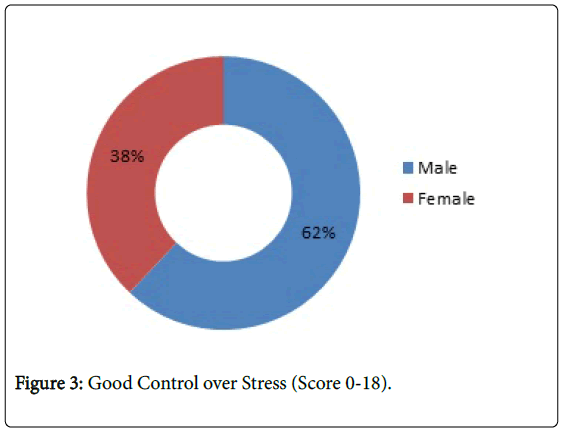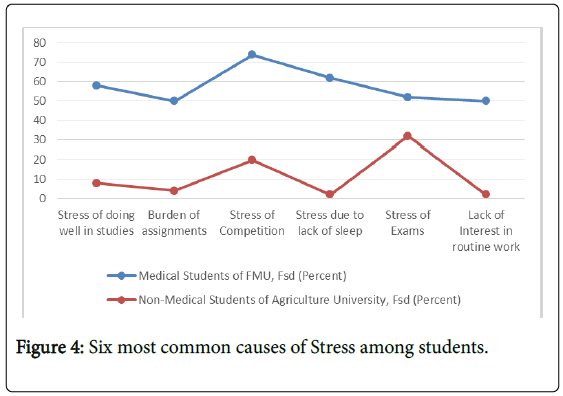Pattern of Stress among Medical Students of Faisalabad Medical University, Faisalabad and Non-Medical Students of University of Agriculture, Faisalabad
Received: 16-Jul-2018 / Accepted Date: 25-Jul-2018 / Published Date: 06-Aug-2018 DOI: 10.4172/2161-1165.1000349
Keywords: Stress; Medical students; Non-medical students; University
Introduction
Stress was generally defined as, “physical, mental, or emotional strain or tension” or “a condition or feeling experienced when a person perceives that demands exceed the personal and social resources the individual is able to mobilize.”
The main concern is that how to measure and define a subjective event like “stress” as it is perceived differently by every human being in response to multiple factors. The set of these triggering factors are different for everybody, influenced by the environment, a man is living in. One of the renowned scientist, defined stress as “the non-specific response of the body to any demand for change”. According to a number of experiments in which laboratory animals were exposed to severe physical as well as emotional stimuli which included extreme of noise, excessive heat or cold, blaring light and in the end response of their bodies, to these stressful events, was recorded (which included gastric ulcers, shrinkage of lymphoid tissue and hyperplasia of the adrenals). These experiments have shown that persistent stress could cause these animals to develop a wide range of diseases similar to those seen in humans, such as cardiovascular, renal and even rheumatological diseases [1]. Hair loss confined to the particular area of the body (alopecia areata) or even of all of the body (alopecia universalis) can be caused by stress [2].
Cause and effect become confused. Dr. Paul J. Rosch a psychiatrist, who has devoted his life for understanding stress, said, “Stress, in addition to being itself, was also the cause of itself, and the result of itself ”. The response of the human body to stressful events includes a whole spectrum of physiological as well as psychological changes. One end of this spectrum shows classical homeostatic disturbances, which include, changes in core body temperature, metabolic substrate concentration or tissue oxygen tension in particular. A novel concept of stressed podocytes has recently been introduced by scientists, who looked into the regulation and putative function of calcium-activated chloride channels, namely bestrophins, under conditions of endoplasmic reticulum stress (ER stress) induced by lipopolysaccharide exposure of renal podocytes [3].
A comprehensive definition of stress should also explain good stress, synonymously called eustress [1]. Eustress refers to a positive response to a stressor, which is dependent on one’s self-control, the period of life he is in, and his social support group, which may include his family, friends, spouse or loved ones [4]. According to the studies and surveys, moderate level of stress is vital for increasing productivity, but there is a point, after which, things get worse rapidly. However, the level of this cut point between the best and the worst performance under stressful situation differs for each of us, as we all have different capabilities to cope with different levels of stress. What we need to be is, be more sensitive to the early warning symptoms and signs that suggest the point of ‘danger’ have reached. Such signals also differ for each of us and can be so acute and mute that they are often gone unnoticed until it is too late [1,2].
It’s been a proven reality that growth in the field of your passion, learning some new skill or gaining some seemingly unachievable goal, is not as straightforward as just going outside your comfort zone. Going anywhere outside your comfort zone causes discomfort. It causes stress. But simply going outside your comfort zone does not guarantee success. The pace of your success depends on how far out you have gone. For the sake of understanding, researchers have divided this venture into three zones (zone of slow growth, ideal zone for growth and zone of destructive anxiety). Researchers have found that mild level of anxiety improves your learning and thus your pace of moving towards your goal, while too much stress impedes your performance. In the zone of destructive anxiety, you may learn and grow something new, but at a high price [5]. Stress prevents memory storage and thus makes learning difficult [6]. The Russian developmental psychologist named the ideal zone as ‘the Zone of Proximal Development’. This is where you'll find the tasks that you can perform if you put in extra effort and received the proper support of either a mentor or a competitive companion [5].
Challenge is an emotion related to the opportunity, which helps someone to get an unmet goal [7]. It is typically convicted that experiencing chronic stress, either in the form of distress or eustress, is negative. However, good stress is the actual driving force that keeps one positively influenced, which in turn reflected in his mental wellbeing and physical fitness [8].
Materials and Method
Study design
A cross-sectional study.
Setting
It was carried out at Faisalabad Medical University, Faisalabad and Agriculture University, Faisalabad. The Agriculture University, Faisalabad was chosen because of easy accessibility and a wide range of non-medical students involved in different ungraduated programs were available. The Agriculture University is the biggest university of the city Faisalabad, with worldwide recognition.
Period
The study was commenced in the month of June 2017.
Sample size
The total of 467 students was given the questionnaire to fill, out of which 413 students returned the filled questionnaire and 13 out of them were partially answered. The study was conducted on remaining 400 students, out of which 200 were medical students of Faisalabad Medical University, Faisalabad and 200 were non-medical students of Agriculture University, Faisalabad belonging to different years of their graduation, socio-economic backgrounds & genders to assess the prevalence of pattern of stress among them. Most of the students were 19-21 years of age. The students of Agriculture University, Faisalabad were involved in different undergraduate programs like Bachelor of Computer Science, Bachelor of Science, and Bachelor of Business Administration.
Data collection and analysis
Questionnaire was pretested via plot survey and is validated. Out of the 467, 413 students returned the filled questionnaire. Among them, only 400 were included in the study. Data was gathered, analyzed and concluded in the Statistical Package for the Social Sciences (SPSS) version 25. Percentages of medical and non-medical students were calculated and compared, for 20 questions of the pretested questionnaire and common causes of stress among students were inferred. Different levels of stress were also calculated and compared among these two groups of students.
Ethical issues
Written informed consent was taken from the candidates who participated in responding the questionnaire and no ethical issue was raised. The ethical committees of both universities were informed, and the study was conducted after their written permission.
Results
Demographics
All of these undergraduate students were of 17-23 years of age, with the mean of 20 years, SD of 2 years and mode of 21 (Table 1).
| Age groups | In case of 200 medical students of PMC (Percent) |
In case of 200 non-medical students of Agriculture University (Percent) |
|---|---|---|
| 17-18 | 32 | 28 |
| 19-20 | 60 | 60 |
| 21-23 | 8 | 12 |
| Total | 100 | 100 |
Table 1: Distribution by age.
When subjects were distributed according to their genders, 46% (92 students) were males, 54% (108 students) were females, among 200 medical students. In the case of 200 students of non-medical students, 57.5% (115 students) were males, and 42.5% (85 students) were females (Figure 1).
Pattern of stress among medical and non-medical students
As per level of stress among them is concerned, out of 200 medical students of Faisalabad Medical University, 20% (40 students) has good control over stress, 72% (144 students) has minimal level of stress, while 4% (8 students) have medium and 4% (8 students) have high level of stress.
In comparison, among 200 non-medical students of Agriculture University, 34% (68 students) have good control over stress, 64% (128 students) have low level of stress, 2% (4 students) have medium level of stress, and no student has high level of stress (Figure 2 and Table 2). Only minimal level of stress is found to be significantly seen more in medical students than in non-medical students.
| t | Standard error | p-value (<0.05) | |
|---|---|---|---|
| Good control over stress (medical v/s non-medical students) | 0.531 | 0.282 | 0.06 |
| Minimal level of stress (medical v/s non-medical students) | 22.14 | 6698.822 | 0.000 |
| Medium level of stress (medical v/s non-medical students) | 0.693 | 0.866 | 0.42 |
| High level of stress (medical v/s non-medical students) | 0.24 | 0.433 | 0.21 |
Table 2: Statistical significance was detected by independent sample ttest.
Population of students with good control over stress (Score 0-18), was analyzed further, on the basis of gender. Out of total of 108 (54%) students with good control over stress, 67 (62.03%) students were males (Figure 3).
Six top most common causes of stress among students includes burden of doing well in studies, burden of assignments, stress of competition, stress due to lack of sleep and stress of exams, as more than 50% students respond to these questions as “very often” cause of their stress. Comparison among medical and non-medical students is illustrated in Figure 4.
Discussion
The study was conducted to assess the level of stress among students of the undergraduate level and focus was not only on academic stress but also on anxiety and stress related to non-academic issues. Medical students are supposed to be more hard-working and career oriented, and a higher level of stress among them was expected as compared to the level of stress among non-medical students. Female students are generally more emotionally liable, which make them more prone to have a higher level of stress or poorer control over stress as compared to male students. We are now discussing and comparing our results with similar studies conducted in the past at institutional or community levels.
A cross-sectional study was conducted on 506 students of four public universities in the Klang Valley, Malaysia, between the ages of 18 and 24 years. They were assessed through self-administered questionnaire, by the Depression Anxiety Stress Scale-21 (DASS-21). All of them belonged to different socio-demographic and family traits and are following different styles of living. The study was concluded that scores for depression and anxiety were significantly higher among students of more than 20 years of age and among those who are dwelling in underdeveloped areas. Whereas, higher proportions of older students, and those whose family incomes were either low or high, have significantly higher stress scores. This study also shows that female students have higher stress scores [9]. According to one study married and elderly female students have a higher level of stress as compared to their junior and single males colleagues [10]. Our study has also shown better control over stress in male population as compared to female population.
Another study was conducted in which focus group discussions were carried out among 19 students (those with A+ grade) of four different academic years in order to unveil the factors influencing high academic achievement according to their perception. This study figured out a number of factors namely; physical and mental presence in lectures, early and multiple revisions, stratifying the learning schedule, conceptual learning, group study and discussions, practical application of theoretical knowledge, learning from mistakes, and healthy family environment. According to those students, managing several non-academic issues like having proper sleep pattern, understanding multiple languages or same language in multiple accents, and dealing with stress can also influence the academic success a lot [11]. High achievers are noticed to have a higher level of stress and anxiety about multiple issues regarding their careers and general lives.
In order to identify the relationship between mental toughness and psychological well-being in undergraduate students, a study was conducted among 168 undergraduate students from nine different universities of the United Kingdom, different degree programs and academic years. It was found that age, gender, and level of the study did not predict psychological well-being of students and demonstrated the potential importance of mental toughness within educational settings [12]. It is important to address the stress among students at institutional, community and family levels. This will not only help them to cope with their academic issues but also their critical personal life issues.
The prevalence of moderate to severe depression and suicidal ideation among medical students was studied through a cross-sectional survey. 14.3% of the 505 students were moderate to severely depressed, and more than half of them were females. More of the older students were reported to have suicidal ideation. It has been also concluded that depression in medical students can endanger patients’ lives. Moreover, younger students were also of the belief that seeking help can make them feel lesser intelligent [13].
A few studies have concluded psychological stress among undergraduate medical students before starting of their medical training was similar to that among the general population. A cohort study has proven this fact. It was conducted among students of first academic year at medical school. DASS-21 has helped to measure stress, anxiety and depression at five different intervals of that one year. The prevalence and level of unfavorable stress and depression during medical training were significantly higher than before the onset medical training [14].
According to some researchers freshly graduated doctors, practicing in hospitals do experience severely high levels of stress, depression and burnout which in turn lead to perceived medical errors, chronic anger, or even suicidal behavior and substance abuse [15]. A number of stressors might be the cause of burden on health professions and medical students such as lack of time for entertaining activities due to workload, having multiple roles, and emotional issues [16]. Medical curriculum is a bit difficult to deal with. Students should be given timetables or trained on how to manage their time, this will help them enjoy extracurricular activities at the times of leisure and their curricular activities as well.
Conclusion
It is concluded that medical students have less ability to cope with their stress as compared to non-medical students. Overall, low level of stress is more prevalent among all the students but is more common in students of medical university. As per good control over stress is concerned, more of the male students own the capability to control their stress.
References
- Rosch PJ (2017) The American institute of stress 2001. Transforming stress through awareness, education and collaboration.
- Behere SP, Yadav R, Behere PB (2011) A comparative study of stress among students of medicine, engineering, and nursing. Indian J Psychol Med 33: 145-148.
- Le Fevre M, Kolt G, Matheny J (2006) Eustress, distress and their interpretation in primary and secondary occupational stress management interventions: Which way first? Journal of Managerial Psychology 21: 547-565.
- Iny D (2016) What Science says about going outside your comfort zone. Inc.
- Smith C, Tong EC, Ellsworth P (2014) The differentiation of positive emotional experience as viewed through the lens of appraisal theory. The Handbook of Positive Emotions, New York: Guilford.
- Crum AJ, Salovey P, Achor S (2013) Rethinking stress: the role of mindsets in determining the stress response. Journal of personality and social psychology. 104: 716-733.
- Shamsuddin K, Fadzil F, Ismail WS, Shah SA, Omar K, et al. (2013) Correlates of depression, anxiety and stress among Malaysian university students. Asian J Psychiatr 6: 318-323.
- Al-Sowygh ZH (2013) Academic distress, perceived stress and coping strategies among dental students in Saudi Arabia. The Saudi dental journal 25: 97-105.
- Abdulghani HM, Al-Drees AA, Khalil MS, Ahmad F, Ponnamperuma GG, et al. (2014) What factors determine academic achievement in high achieving undergraduate medical students? A qualitative study. Med Teach 36 Suppl 1: S43-48.
- Stamp E, Crust L, Swann C, Perry J, Clough P, et al. (2015) Relationships between mental toughness and psychological wellbeing in undergraduate students. Personality and Individual Differences 75: 170-174.
- Schwenk TL, Davis L, Wimsatt LA (2010) Depression, stigma, and suicidal ideation in medical students. JAMA 304: 1181-1190.
- Yusoff MS, Rahim AF, Baba AA, Ismail SB, Pa MN, Esa AR (2013) The impact of medical education on psychological health of students: a cohort study. Psychol Health Med 18: 420-430.
- Myszkowski N, Villoing B, Zenasni F, Jaury P, Boujut E (2017) Monitoring stress among internal medicine residents: an experience-driven, practical and short measure. Psychol Health Med 22: 719-726.
- McCann CM, Beddoe, E, McCormick, K, Huggard, P, Kedge S, et al. (2013) Resilience in the health professions: A review of recent literature. International Journal of Wellbeing 3: 60-81.
Citation: Jahngir MU, Imam HSH, Ahmad MQ, Jahangir M, Fraz MA, et al. (2018) Pattern of Stress among Medical Students of Faisalabad Medical University, Faisalabad and Non-Medical Students of University of Agriculture, Faisalabad. Epidemiology (Sunnyvale) 8: 349. DOI: 10.4172/2161-1165.1000349
Copyright: © 2018 Jahngir MU, et al. This is an open-access article distributed under the terms of the Creative Commons Attribution License, which permits unrestricted use, distribution, and reproduction in any medium, provided the original author and source are credited.
Select your language of interest to view the total content in your interested language
Share This Article
Recommended Journals
Open Access Journals
Article Tools
Article Usage
- Total views: 6728
- [From(publication date): 0-2018 - Nov 28, 2025]
- Breakdown by view type
- HTML page views: 5766
- PDF downloads: 962




